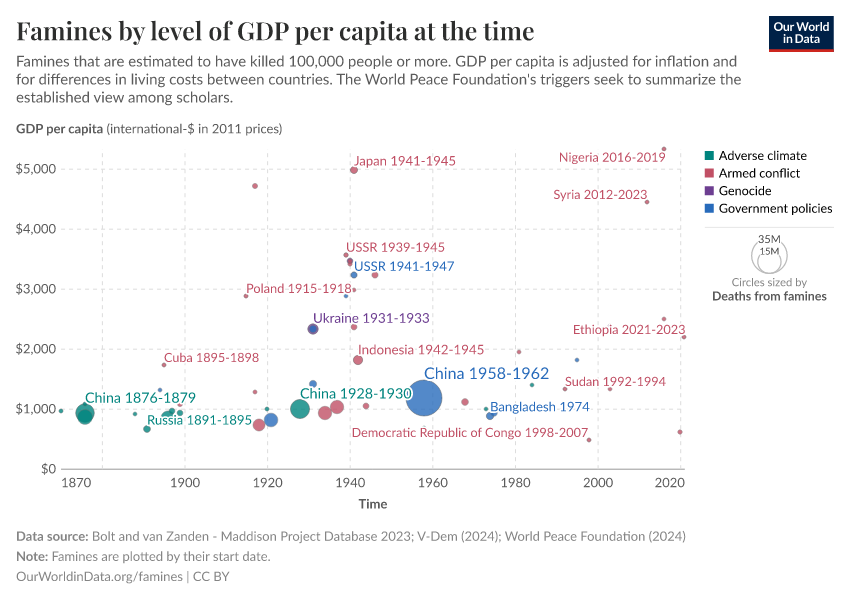GDP per capita

What you should know about this indicator
- The Maddison Project Database is based on the work of many researchers who have produced estimates of economic growth and population for individual countries. The full list of sources for this historical data is given in the original dataset.
- Gross domestic product (GDP) is a measure of the total value added from the production of goods and services in a country or region each year. GDP per capita is GDP divided by population.
- This indicator provides information on economic growth and income levels in the very long run. Some country estimates are available as far back as 1 CE, and regional estimates as far back as 1820 CE.
- This data is adjusted for inflation and for differences in living costs between countries.
- This data is expressed in international-$ at 2011 prices, using a combination of 2011 and 1990 PPPs for historical data.
- Time series for former countries and territories are calculated forward in time by estimating values based on their last official borders.
- For more regularly updated estimates of GDP per capita since 1990, see the World Bank's indicator.
Related research and writing
Frequently Asked Questions
What are international-$ and why are they used to measure incomes?
Much of the economic data we use to understand the world — for instance, on the goods and services bought or produced by households, firms and governments, or the incomes they receive — is initially recorded in terms of the units in which these transactions took place. That means this data starts out being expressed in a variety of local currencies — such as rupees, US dollars, or yuan, etc. — and without adjusting for inflation over time. This is known as being in “current prices”, or in “nominal” terms.
Sources and processing
This data is based on the following sources
How we process data at Our World in Data
All data and visualizations on Our World in Data rely on data sourced from one or several original data providers. Preparing this original data involves several processing steps. Depending on the data, this can include standardizing country names and world region definitions, converting units, calculating derived indicators such as per capita measures, as well as adding or adapting metadata such as the name or the description given to an indicator.
At the link below you can find a detailed description of the structure of our data pipeline, including links to all the code used to prepare data across Our World in Data.
Notes on our processing step for this indicator
When GDP data was missing for certain years but nearby estimates were available, we used the closest or most relevant data. For example, during Cuba's famine from 1895 to 1898, we used the GDP from 1892. For China’s famine from 1876 to 1879, we used the average GDP from 1870 to 1887. In special cases like Russia and Kazakhstan (1932 to 1934), we used the USSR’s average GDP from 1940 to 1946. For recent gaps, we used 2022 data for countries like the Central African Republic, Ethiopia, and Syria.
Reuse this work
- All data produced by third-party providers and made available by Our World in Data are subject to the license terms from the original providers. Our work would not be possible without the data providers we rely on, so we ask you to always cite them appropriately (see below). This is crucial to allow data providers to continue doing their work, enhancing, maintaining and updating valuable data.
- All data, visualizations, and code produced by Our World in Data are completely open access under the Creative Commons BY license. You have the permission to use, distribute, and reproduce these in any medium, provided the source and authors are credited.
Citations
How to cite this page
To cite this page overall, including any descriptions, FAQs or explanations of the data authored by Our World in Data, please use the following citation:
“Data Page: GDP per capita”, part of the following publication: Bastian Herre, Veronika Samborska, Joe Hasell, and Max Roser (2017) - “Famines”. Data adapted from Bolt and van Zanden. Retrieved from https://data-korevaar-housing.owid.pages.dev:8789/20250624-125417/grapher/famines-by-level-of-gdp-per-capita-at-the-time.html [online resource] (archived on June 24, 2025).How to cite this data
In-line citationIf you have limited space (e.g. in data visualizations), you can use this abbreviated in-line citation:
Bolt and van Zanden - Maddison Project Database 2023 – with minor processing by Our World in DataFull citation
Bolt and van Zanden - Maddison Project Database 2023 – with minor processing by Our World in Data. “GDP per capita – Maddison Project Database – In constant international-$. Historical data” [dataset]. Bolt and van Zanden, “Maddison Project Database 2023” [original data]. Retrieved July 14, 2025 from https://data-korevaar-housing.owid.pages.dev:8789/20250624-125417/grapher/famines-by-level-of-gdp-per-capita-at-the-time.html (archived on June 24, 2025).